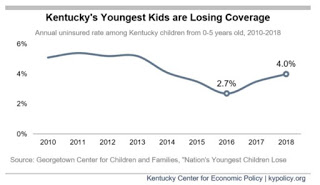Kentucky had nation’s third largest increase in 2016-18 in percentage of children under 6 without health insurance

By Melissa Patrick
Kentucky Health News
Over the past two years, Kentucky saw the third largest increase in the nation for the percentage of children under 6 years of age with no health insurance, says a Georgetown University study.
The university’s Center for Children and Families’ analysis of the most recent census data found the rate of uninsured children under 6 in Kentucky rose from 2.7 percent to 4 percent between 2016 and 2018. That was a bigger jump than the increase in the national rate during the period, from 3.8% to 4.3%.
The state’s rate had been trending down since 2014, when the state fully implemented the 2010 Patient Protection and Affordable Care Act.
The rate was 5.2% in 2013, 4.1% in 2014, 3.5% in 2015 and 2.7% in 2016, before increasing in 2017 to 3.5% and to 4% in 2018.
The estimated number of uninsured Kentucky children under 6 rose from 8,608 in 2016 to 12,973 in 2018, meaning that 4,365 more didn’t have coverage, a 50.7% increase.
 |
| Chart from Georgetown report; click on it for larger version |
Kentucky was one of 11 states that showed a significant increase in both the rate and number of uninsured young children, says the report. It doesn’t say whether the increase is specific to any one type of coverage.
In a blog post about the report, the liberal-leaning Kentucky Center for Economic Policy reports that the Georgetown finding is in line with the broader coverage losses seen in Kentucky from 2016 to 2018. “But the increase in the number of uninsured young children (50.7%) far outpaced the increase in the number of uninsured Kentuckians as a whole (10.9%),” writes KCEP policy analyst Dustin Pugel.
The Georgetown report says it is critical for this age group to have health insurance, not only for medical care during a time that includes rapid brain development and physical growth, but also because it protects families from financial risk that can come from an unexpected injury or illness. Further, it points to research that shows health insurance for children is linked to better health, educational, and economic outcomes well into adulthood.
The American Academy of Pediatrics recommends that children get 15 checkups before age 6. These early visits include not only vaccinations and preventive care, but screenings that can detect developmental delays to allow for early intervention.
The Georgetown report notes that the increases occurred during a time of economic growth, “when children should be gaining health care coverage,” not losing it. The report says a number of factors could have contributed to this coverage reversal, including declines in Medicaid and in the Children’s Health Insurance Program.
It adds that these declines have likely been influenced by the Trump administration’s “policies and rhetoric targeting immigrant families,” which has reportedly deterred many parents from signing up eligible-citizen children in available Medicaid and CHIP coverage.
It also points to ongoing national policy debates and decisions that it says have “undoubtedly sowed confusion among parents and caregivers about whether coverage would be available to their children.”
Specifically, the report points to the 2017 efforts in Congress to repeal the ACA and severely cut Medicaid, along with months-long delay in extending the children’s insurance program funding, as well as cuts to national outreach grants.
Adding to Kentuckians’ confusion, Pugel notes, they also had to keep up with the status of the Medicaid program, which then-Gov. Matt Bevin was trying to change with, among other things, work requirements. The proposal has been blocked by a federal judge, and new Gov. Andy Beshear has said he plans to rescind the proposal.
Kentucky’s numbers would likely be higher if it had not expanded Medicaid to adults who have earnings just above the poverty line. The report shows that young children were more likely to be uninsured in states that did not expand Medicaid.
“Research shows that when adults have access to coverage, they are more likely to enroll their eligible children,” says the report. This is often called the “welcome mat.”
The report adds that young children tend to be uninsured at lower rates than their school-aged peers. However, Kentucky and six other states have shown an opposite trend; in Kentucky, 4% of its young children are uninsured, compared to 3.7% of school-aged children.
“For these states, the inversion serves as a potential warning sign that more could be done to reach uninsured young children,” says the report.
A spokesperson for the Cabinet for Health and Family Services said Friday that the agency would need time to review the report before offering comment.